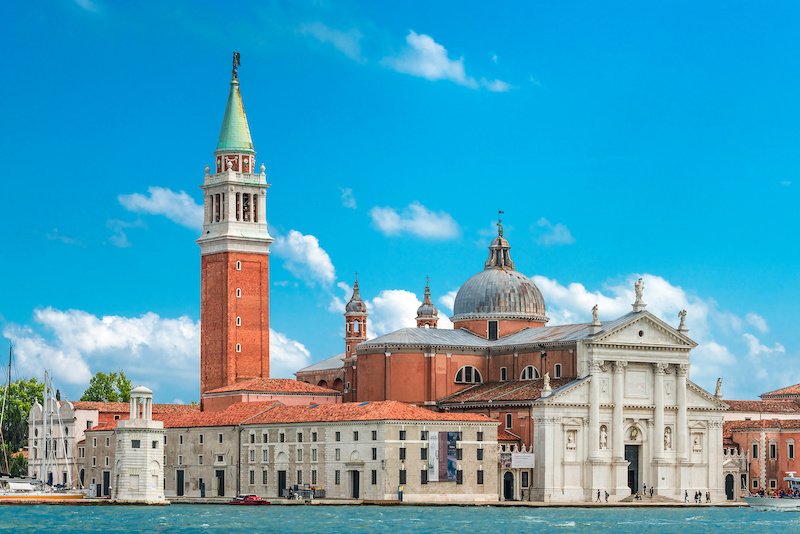If you’re staying in Venice, you’ll surely have your smartphone filled with photos and videos of Venice, the city “suspended in time.” In addition to the monuments, canals, gondolas, and alleys to capture in one or more shots, the views of Venice are undoubtedly among the most beautiful in the world.
The skylines immortalized on the horizon, here and there across the lagoon, will undoubtedly be the scenarios that each tourist will jealously treasure in their memory at the end of their stay.
One of the most enchanting views to admire and photograph is the one that unfolds in the San Marco Basin in front of the marvelous square of the same name. There are two islands: Giudecca and San Giorgio Maggiore.
The island of San Giorgio Maggiore and the ancient convent
It is the smallest of the two and also the least visited by tourist circuits. For this reason, the island still maintains an ancient charm unchanged that has its roots in the distant tenth century when the Benedictine monks founded their convent here, with a church next to it, which over the years became one of the most flourishing centers in theological and artistic fields.
Palladio’s intervention on the monastery and the church of San Giorgio Maggiore
It was between 1560 and 1562 that the most important works were carried out: Andrea Palladio’s refectory and the immense canvas that was to adorn it: we are talking about Paolo Veronese’s Wedding at Cana. Subsequently, given the great success achieved by Palladio for the construction of the refectory, the church of San Giorgio Maggiore was also modernized. In 1643, the grand staircase was built, in 1652 the new facade, and in 1680 the guesthouse. For the facade in particular, Palladio refers to classical pagan temples with a triangular pediment and a portico with four columns.
The years of the decline of the monastery
They were years of intense work and a flourishing period that ended abruptly in 1797 when Napoleon had the famous canvas of the Wedding at Cana transferred to Paris. Today the work is exhibited at the Louvre Museum. In 1806 the monastery was then suppressed by Napoleon’s laws and many works contained within it were stolen or sold. Even in the subsequent years, under the Austro-Hungarian and Italian empires, the monastery remained a military garrison undergoing a rapid decline. Today the former convent is the headquarters of the Cini Foundation, which hosts numerous exhibitions, events, and concerts.
The Church
The interior of the church, very bright, is a Latin cross with three naves and preserves works by great masters such as Tintoretto and Carpaccio. In particular, on the main altar, a work by Girolamo Campagna, the two grandiose works by Tintoretto are kept: The Last Supper and the Gathering of the Manna.
The Bell Tower
If you’ve been to the top of the most famous bell tower of San Marco to admire the fabulous panorama of the lagoon city at 360 degrees, you can’t help but climb up to the top of this second bell tower, 75 meters high, dating back to 1791 and built following the style of the San Marco tower itself. The bell chamber is made of Istrian stone and surmounted by a cylindrical body supporting the conical spire. At the top is a rotating angel. The bell tower has an elevator to reach the terrace of the bell chamber. The view is the most complete in Venice: from here you have a view of the San Marco Basin, the Grand Canal, the Giudecca Canal, the Lido, Sant’Elena, and some smaller islands in the southern lagoon. In the distance, to the north and northwest, on clear days, you can admire the Alps and, to the west, the Euganean Hills.
Useful info
The small island of San Giorgio Maggiore can be reached by vaporetto (line 2 from Piazzale Roma, from the train station, or from San Marco). The Basilica is open every day. April/October 9-19 November/March 8.30-18 The entrance to the Church is free while to climb to the top of the bell tower it is necessary to pay a ticket of € 6.00


